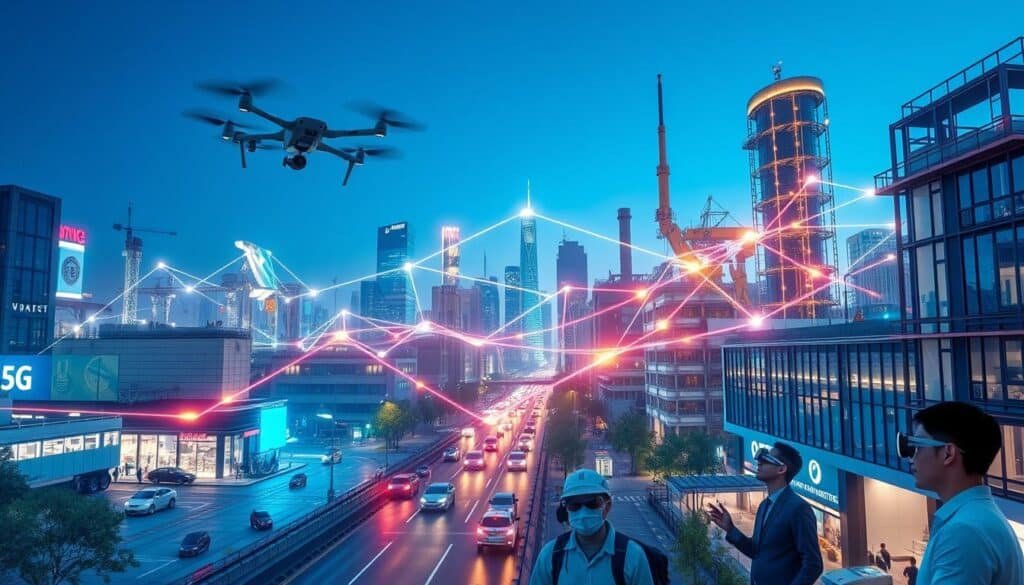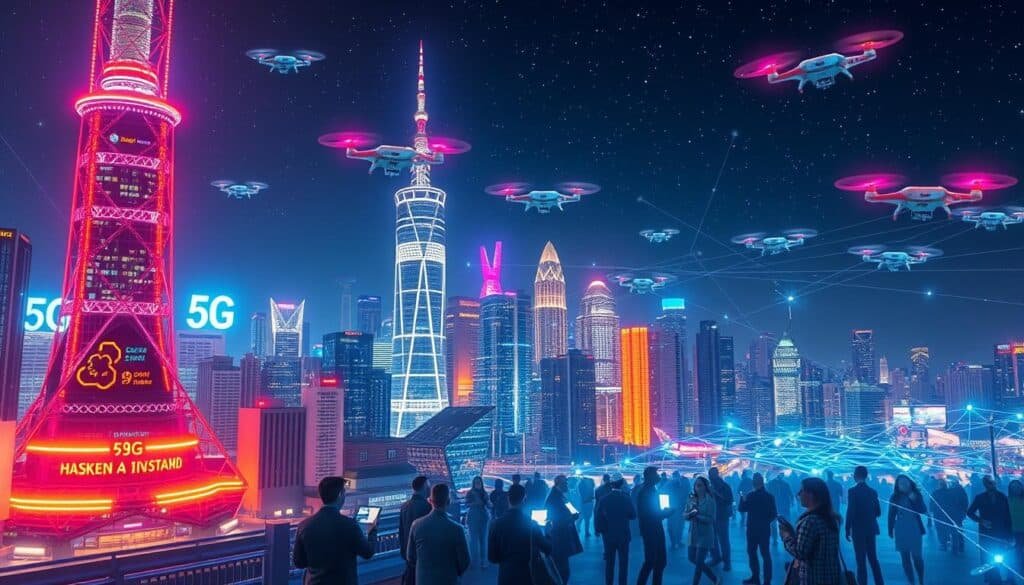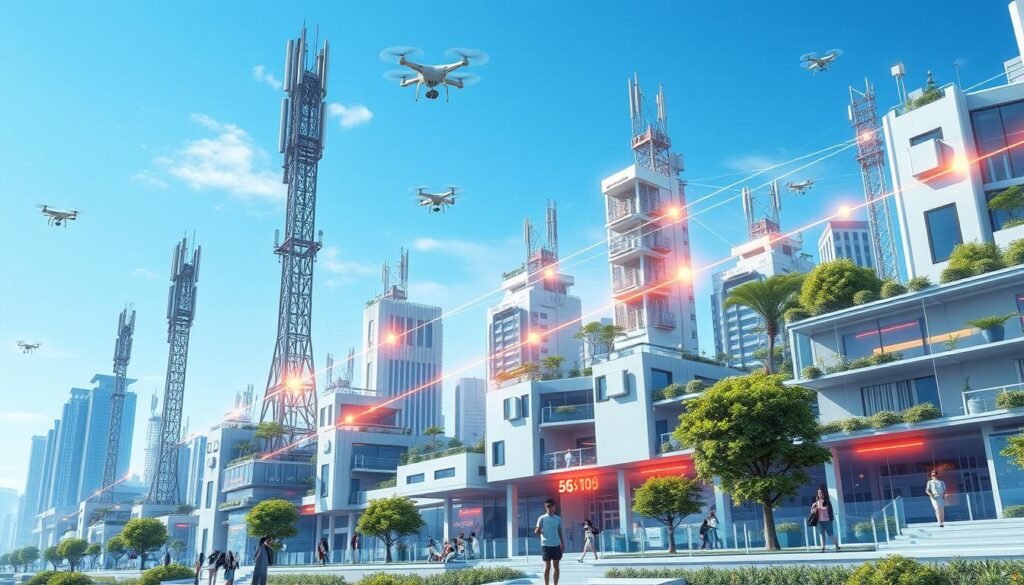5G has changed the game in wireless tech, bringing faster and better connectivity. Now, 62% of smartphones can use 5G, changing how we talk, work, and enjoy online. Big names like Verizon, AT&T, and Google are leading the 5G charge, covering over 200 million places. They aim to double this number in the next four years.
5G was created in 2018 by the 3GPP. It uses new radio waves for super-fast data, low delay, and more room for data. This means we can do more and experience better online interactions than before.
Key Takeaways
- 62% of smartphones are now 5G-compatible, indicating rapid adoption in the industry.
- Major telecom providers in North America offer 5G coverage to over 200 million homes and businesses, with plans to double this reach in the next four years.
- 5G technology promises faster download and upload speeds, lower latency, and increased bandwidth, enabling new applications and innovations.
- 5G is expected to revolutionize industries such as healthcare, smart cities, and manufacturing through advanced connectivity and data capabilities.
- Widespread deployment of 5G networks can help expand internet access and improve affordability for underserved communities.
Understanding 5G Technology Fundamentals
The 5G network is a big step up in wireless tech. It brings fast speeds and new ways to connect and share info. At its heart is the 5G NR standard, which makes 5G networks super fast, up to 20 Gbps. That’s way faster than 4G.
How 5G Networks Operate
5G networks use a cellular setup. Devices connect to the internet via radio waves from 5G antennas and base stations. Unlike before, 5G can handle millions of devices in a small area. This is thanks to small cells and macro towers using different spectrum bands.
Key Features of 5G Infrastructure
- Significantly faster data transmission speeds, up to 10 Gbps
- Reduced latency, with response times as low as 1 millisecond
- Enhanced network capacity to support more connected devices
- Improved energy efficiency and cost-effectiveness
Network Architecture and Components
The 5G network is more flexible and scalable than before. It uses network slicing for personalized services. This means private 5G networks for businesses. The 5G ecosystem includes many advanced parts, all working together for a better user experience.
“5G technology offers unprecedented opportunities for innovation, with the potential to transform industries and revolutionize the way we live, work, and interact with the world around us.”
The Evolution from Previous Wireless Generations

The move from 3G and 4G to 5G is a big step forward in wireless tech. 5G networks bring many improvements, making them ready for the high-speed, low-latency needs of today.
5G’s infrastructure is smaller and uses less power. This means we can have more devices connected at once. It’s a big change from the older systems.
5G uses more radio frequencies than before. This includes low-band, mid-band, and high-band spectrums. It gives better bandwidth and can handle more users without slowing down.
5G also has a better way to send data, called adaptive Modulation and Coding Scheme (MCS). This means fewer errors and a smoother experience for users.
The shift to 5G is driven by our need for faster, better, and more versatile internet. GSMA Intelligence says we’ll see over two billion 5G connections by 2025. By then, more than two in five people worldwide will be near a 5G network.
As mobile operators keep investing in 5G, it’s set to change many industries. From healthcare to smart cities, 5G is ready to bring new levels of connectivity and innovation.
Revolutionary Impact on Industries and Innovation

5G technology is changing many industries, opening up new chances for innovation. Its fast speeds, low latency, and better connectivity are changing healthcare, smart cities, and manufacturing.
Healthcare and Telemedicine Advancement
In healthcare, 5G makes remote procedures possible, improves patient tracking, and speeds up medical image sharing. It also supports real-time remote surgery with sub-10-millisecond latency. This lets experts do complex surgeries from afar.
5G also powers wearable devices and IoT sensors. These tools keep an eye on patient health, giving doctors the data they need quickly.
Smart Cities Development
5G is making smart cities a reality. It helps manage traffic better, letting cars talk to each other and the city’s systems. This cuts down on traffic jams and makes roads safer.
5G also helps cities track air quality and use AI to manage resources. For example, Vienna’s WienBot uses 5G to improve city services and quality of life.
Manufacturing and Industrial Applications
In manufacturing and logistics, 5G is changing how supply chains work. IoT devices, shelf sensors, and automated systems use 5G to boost efficiency and productivity.
Edge computing, made possible by 5G, lets businesses analyze data in real-time. This gives them better control over their operations. It’s a key part of Industry 4.0.
| Industry | 5G Impact | Key Applications |
|---|---|---|
| Healthcare | Enables remote procedures, improves patient monitoring, and facilitates faster medical imaging data transmission | Telemedicine, remote surgery, connected medical devices |
| Smart Cities | Enhances traffic management, air quality monitoring, and enables AI-powered solutions | Connected vehicles, environmental sensors, intelligent automation |
| Manufacturing and Logistics | Improves supply chain efficiency through IoT devices, shelf sensors, and automated checkouts; enables edge computing for real-time insights | Supply chain optimization, industrial IoT, edge computing |
The impact of 5G on industries is huge. It’s opening up new chances in healthcare, smart cities, and manufacturing. 5G is leading us to a more connected, efficient, and innovative future.
Enhanced Consumer Experiences and Connectivity

5G technology is changing how we use digital experiences. It offers fast speeds and low latency, making augmented reality (AR) and virtual reality (VR) better. This means better gaming, entertainment, and shopping online.
Now, you can pick your camera angle during live sports or get product suggestions based on what you like. It’s all thanks to 5G.
5G is also making customer service better. Artificial intelligence (AI) works faster with 5G, helping with customer questions. Plus, 5G connects more devices, making supply chains more efficient and reducing waste.
At work, 5G makes remote meetings more engaging. With AR, meetings become more interactive and productive. Businesses need to update their tech and train their teams to use 5G well.
The metaverse, a mix of real and digital worlds, will also benefit from 5G. Fast and reliable internet is key for smooth virtual interactions. 5G makes the metaverse more fun and useful for socializing, entertainment, and shopping.
In the end, 5G is changing how we experience the world. It opens up new opportunities for businesses. As 5G spreads, companies must be quick to adapt and innovate to succeed.
5G Technology Implementation Challenges

The world is excited about 5G technology, but there are many challenges to overcome. These include building the infrastructure, ensuring security, and dealing with the cost. All these obstacles need to be tackled for 5G to be widely adopted.
Infrastructure Development Hurdles
Setting up 5G networks needs a lot of investment. This includes installing many antennas and upgrading cell towers. A report by PwC says 5G could add $13.2 trillion to the global economy by 2035. But, the cost of these upgrades is high, especially for areas with less money.
Security and Privacy Concerns
5G networks are more connected and use more data, which raises security and privacy worries. We must protect against hacking and cyberattacks to keep information safe. With more devices connected, we also need strong security to protect user privacy.
Cost and Accessibility Issues
5G services are expensive because of the needed infrastructure and advanced features. This makes 5G hard to afford and access, widening the digital divide. It could make it harder for some to get this new technology.
To move forward with 5G, we need to work together. We must solve the problems of infrastructure, security, and cost. Doing so will unlock 5G’s full potential, bringing better connectivity, innovation, and growth for everyone.
| Challenge | Impact | Potential Solution |
|---|---|---|
| Infrastructure Development | High costs associated with the installation of dense antenna networks and cell tower upgrades | Collaborative efforts between governments, telecom providers, and private entities to share infrastructure costs and streamline deployment |
| Cybersecurity and Privacy | Increased vulnerability to hacking and data breaches due to the expanded network of connected devices | Robust security measures, data encryption, and clear privacy policies to protect user information |
| Cost and Accessibility | Higher initial costs of 5G service, potentially widening the digital divide and limiting access to underserved communities | Government subsidies, public-private partnerships, and innovative pricing models to ensure affordable and widespread 5G availability |
“By 2035, 5G is predicted to generate $13.2 trillion in economic value globally according to a report on the impact of 5G published by PwC.”
Also Read: Cloud Computing For Small Businesses
Conclusion
5G technology is changing how we connect and will start a new digital age. It brings fast speeds, low delays, and reliable connections. These features will open up new uses in healthcare, smart cities, and more.
But, there are hurdles like building new networks, keeping data safe, and the cost. Still, the gains from 5G are big. It will change how we use telemedicine, drive cars, and connect devices. It will also make watching videos, playing games, and working from home better.
As 5G grows and spreads, its full effect is still to come. But, one thing is clear: 5G will lead to big changes in technology and how we live. It will shape our world in the next few years.
FAQs
Q: What is 5G and how fast is 5G compared to previous generations?
A: 5G is the fifth generation of mobile network technology, which offers significantly faster speeds and lower latency compared to 4G. The 5G speed can reach up to 10 Gbps under ideal conditions, making it capable of supporting a wide range of applications and services.
Q: What types of 5G phones are available on the market?
A: There are various 5G phones available, including flagship models from major manufacturers like Apple, Samsung, and Google. These devices are designed to support 5G connectivity, allowing users to experience the benefits of 5G mobile networks.
Q: What are some common 5G use cases?
A: 5G use cases include enhanced mobile broadband, IoT applications, smart cities, autonomous vehicles, and remote healthcare. These applications benefit from the high bandwidth and low latency that 5G technology offers.
Q: What are the benefits of 5G technology?
A: The benefits of 5G include faster download speeds, reduced latency, increased network capacity, and improved reliability. This enables better streaming, gaming, and connectivity for multiple devices simultaneously.
Q: How does 5G work in comparison to previous technologies?
A: 5G works using a combination of low-band, mid-band, and high-band spectrum (including mmWave), allowing for a diverse range of applications. Unlike 4G, which primarily uses low-band frequencies, 5G can utilize higher frequencies for faster speeds and increased capacity.
Q: What is Verizon 5G and how does it differ from other mobile operators?
A: Verizon 5G is Verizon’s implementation of 5G technology, offering both low-band and ultra-wideband options. It aims to provide extensive coverage and high-speed connectivity, differentiating itself from other mobile operators by its focus on a robust 5G home internet and ultra capacity services.
Q: Can you explain 5G home internet and its advantages?
A: 5G home internet utilizes 5G technology to provide high-speed internet to homes without the need for traditional broadband connections. Its advantages include faster speeds, lower latency, and the ability to connect multiple devices simultaneously without degradation of service.
Q: What is the difference between 5G ultra wideband and low-band 5G?
A: 5G ultra wideband operates on high-band frequencies, providing extremely high speeds and low latency but with limited range. In contrast, low-band 5G offers broader coverage but at slower speeds compared to ultra wideband. Both serve different use cases depending on user needs.
Q: How do I use a 5G device, and what do I need to get started?
A: To use a 5G device, you need a compatible 5G phone and a mobile plan that supports 5G connectivity. Check your area for 5G coverage to ensure you can access the network. Once set up, you can enjoy the enhanced capabilities of 5G technology.
Source Links
- https://www.ibm.com/think/insights/5g-future
- https://www.forbes.com/councils/forbestechcouncil/2022/12/20/the-future-of-5g-benefits-and-challenges/
- https://www.jabil.com/blog/understanding-5g-and-the-future-of-living-and-working.html
- https://www.cisa.gov/sites/default/files/publications/5g_basics_infographic_508.pdf
- https://www.redhat.com/en/topics/5g-networks
- https://newsroom.uscellular.com/the-evolution-and-impact-of-5g-technology/
- https://www.uniconvergetech.in/blog/evolution-of-wireless-technology
- https://www.cengn.ca/information-centre/innovation/timeline-from-1g-to-5g-a-brief-history-on-cell-phones/
- https://atpconnect.org/the-role-of-5g-in-iot-accelerating-the-fourth-industrial-revolution/
- https://www.expresscomputer.in/guest-blogs/5g-the-next-wave-of-network-innovation/119865/
- https://www.infosysbpm.com/blogs/business-transformation/benefits-of-5g-not-only-in-network-connection.html
- https://www.noobpreneur.com/2024/02/14/the-impact-of-5g-on-business-operations-and-customer-experiences/
- https://www.neuralt.com/news-insights/5g-connectivity-transforming-consumer-experience
- https://www.linkedin.com/pulse/impact-5g-technology-digital-experience-42-interactive-xkuzc
- https://decisiontele.com/news/perspectives-and-barriers-5g-implementation-and-its-impact-small-and-medium-businesses.html
- https://www.jabil.com/blog/5g-challenges.html
- https://stl.tech/blog/challenges-in-implementing-5g/
- https://sageuniversity.edu.in/blogs/5g-network-technology-and-its-impact-on-society
- https://pmc.ncbi.nlm.nih.gov/articles/PMC10041185/
- https://www.icertglobal.com/the-rise-of-5g-technology-and-its-implications-blog/detail





